#australian national maritime museum
Explore tagged Tumblr posts
Text
For #WorldDugongDay:



Alick Tipoti (Torres Strait: Badhu Island, Kala Lagaw Ya, b.1975)
Kisay Dhangal, 2016
Sculpture, bronze with mother-of-pearl inlay
194 × 202 × 102 cm, 280 kg
Australian National Maritime Museum 00054952
"Inscribed with traditional motifs and pearl shell, Kisay Dhangal reflects the life cycle and feeding patterns of the dhangal (dugong) in the Torres Strait Islands. The dhangal is captured in the position known as San Tidayk, in Kala Lagaw Ya language which marks the moment the mammal flips its tail to dive down and graze on the sea grass beds. A marine dust trail between the tail and figure of the moon emphasize how lunar cycles determine dugong feeding and mating habits."
#Alick Tipoti#animals in art#animal holiday#sculpture#metalwork#bronze#Indigenous art#Australian art#Torres Strait Islander art#contemporary art#Australian National Maritime Museum#dugong#World Dugong Day#marine mammals#Sirenians#ethnozoology
167 notes
·
View notes
Text

Australian National Maritime Museum, Sydney, Australia
Victor
0 notes
Text
youtube
Process Change: Adapting & Adopting New Models | Future of Arts, Culture & Technology Symposium 2023
Building on the two preceding talks, this session explores how arts organisations are seizing new technological opportunities and how they are changing their operational models to co-create and collaborate with others. Paula Bray (Head of Digital Engagement & Insight, Australian National Maritime Museum) draws on her work running creative R&D labs within museums and libraries; Back to Back Theatre's Executive Producer & Co-CEO Tim Stitz has helped create and lead multi-award winning cross-disciplinary theatre and screen productions, and Junior Major's Director Claire Evans brings decades of experience in creative production with media and technologies to the discussion.
1 note
·
View note
Text
Ever wondered what a shark bite to a human head looks like?

Meet Iona Asai, a pearl diver from Saibai Island in the Torres Strait. In 1937 Iona was diving for pearls off the boat Sau when he was attacked by a shark. According to Iona’s own account, the shark wrapped its jaws around his head and neck and bit down, but Iona dug his fingers into its eyes until it let him go. He managed to swim back to the boat, where he was dragged from the water by the captain and passed out.

With Iona unconscious and heavily bleeding, and the nearest doctor over 100 kilometers (62 miles) away, the Sau made its way to the nearest populated island, where a school teacher provided them with medication. Iona’s injuries required over 150 stitches, which he received while conscious and without anesthetic.
If that wasn’t enough, they were later able to identify the species of shark, despite Iona never getting a chance to look at it properly. How?
They found a chunk of one of its teeth still embedded in the back of his neck almost a week later.
And do you want to know the really incredible thing? This wasn’t even the first time Iona Asai was attacked by a shark and lived to tell the tale, having survived an attack off the coast of Cairns previously.
Iona made a full recovery from his ordeal.
These images, printed on photographic postcards at the time, were donated to State Library of Queensland. You can view the full record here.
#sharks#shark attack#shark#australia#australian history#did you know#maritime#maritime history#ocean#ocean fun facts#First Nations#First Nations stories#Iona Asai#from the collections#library#libraries#support libraries#museum#antique#history#historical#queensland history#state library of queensland#librarian aesthetic#libraries and museums#NAIDOC#Torres Strait#torres strait islanders#straya#deceased
47 notes
·
View notes
Text



Adventuresses We Love – Kay Cottee
Adventuress Kay Cottee pretty much grew up on the water. She spent a good bit of her youth sailing Sydney Harbor in a boat her father had built. It wasn’t long before she was building boats herself and discovered her love of racing them. But she had a bigger goal in mind.
On 29 November 1987, Cottee sailed out of Sydney Harbor aboard her 37ft yacht, Blackmores First Lady and headed west. Her plan? To sail around the world nonstop, alone and unassisted.
The seas were rough. She was battling against 100-knot winds and 20-meter waves through much of early days, waves that knocked the First Lady over multiple times. One such knock over, off the coast of Africa, broke the First Lady’s boom and washed Cottee overboard. She was able scramble back aboard, fix the boom, and keep going.
One night, she woke from sleep to see a commercial fishing vessel bearing down on her. The fishing vessel’s crew had no idea she and the First Lady were there. She managed to fire off a flare, alerting the fishermen, who were able to divert their ship, and avoid the collision, at the last possible moment.
Finally, on 5 June 1988, after 189 days at sea, Adventuress Kay Cottee and Blackmores First Lady sailed back under the Sydney Harbor Bridge, becoming the first woman to complete a solo, nonstop, and unassisted circumnavigation of the world.
Adventuress Kay Cottee still sails, builds boats, and paints and sculpts in New South Wales. Blackmores First Lady is now part of the collection of the Australian National Maritime Museum in Sydney.
10 notes
·
View notes
Text
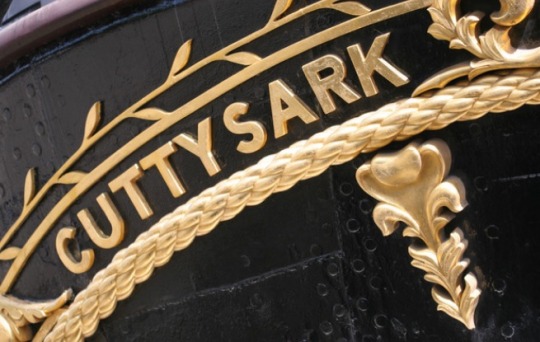

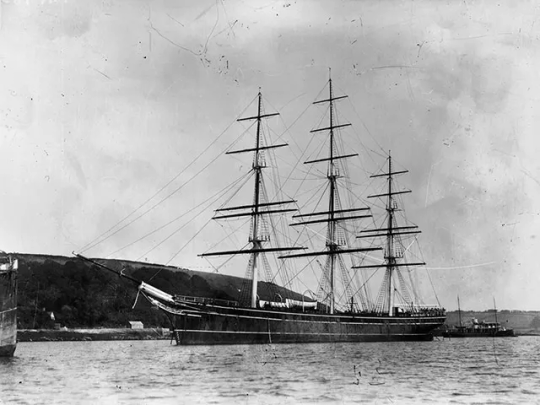

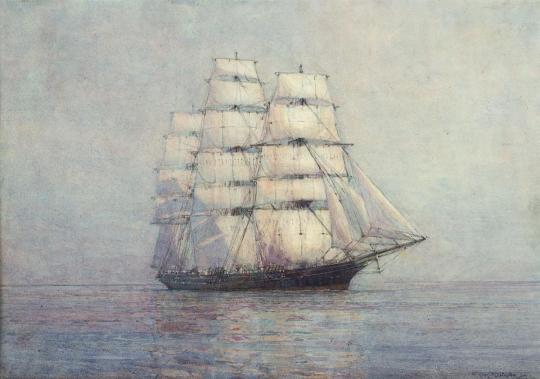
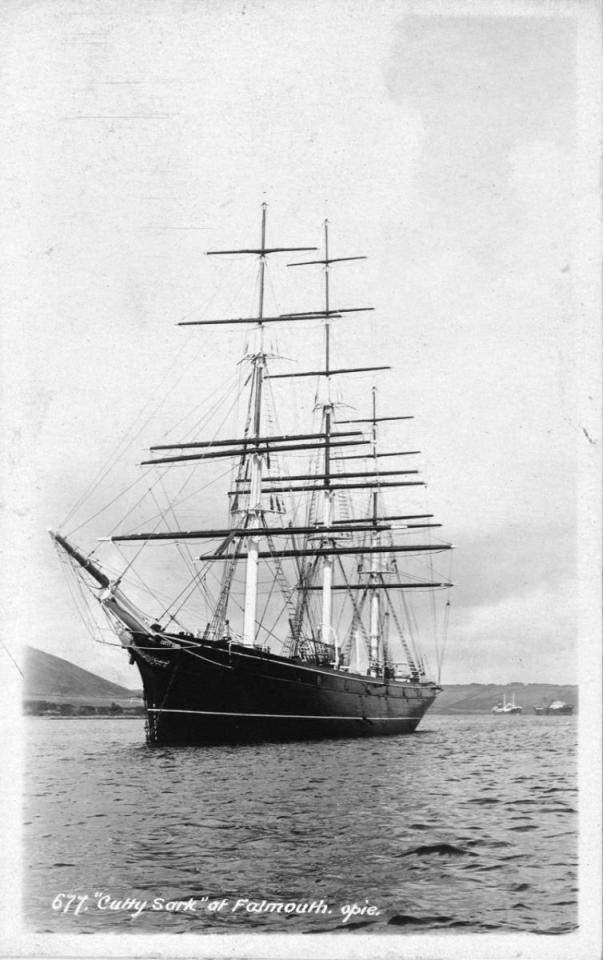
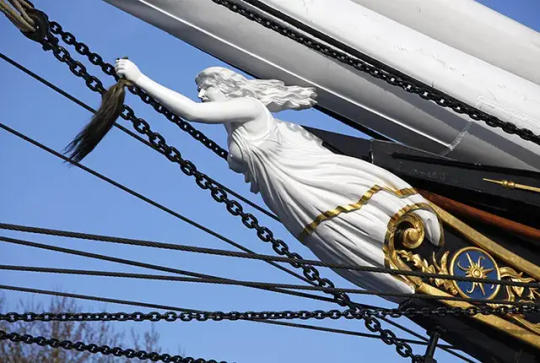
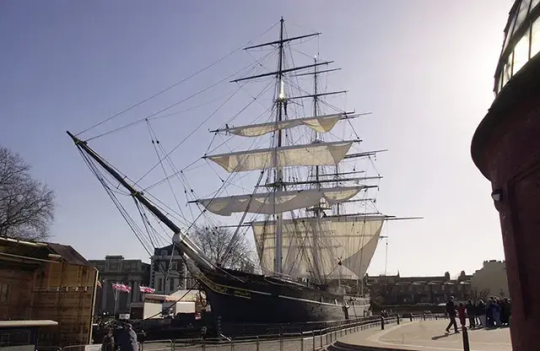
On 22nd November 1869 the clipper "Cutty Sark" was launched at Dumbarton on the River Clyde.
Cutty Sark was built for a firm of ship owners called Willis & Sons, headed by John ‘Jock’ Willis, whose ambition was that she be the fastest ship in the annual race to bring home the first of the new season’s tea from China.
She was designed by Hercules Linton, a partner in the Dumbarton firm of Scott & Linton. It is believed that he moulded the bowlines of Willis’s earlier vessel Tweed into the midship attributes of Firth of Forth fishing boats, creating a beautiful new hull shape that was stronger, could take more sail, and be driven harder than any other.
The company had never built a ship of this size before and ran into financial difficulties, eventually going bankrupt before she was completed. The final details of the fitting out had to be completed by William Denny & Brothers, Scott & Linton’s landlords and the guarantors for the completion of the work on the original contract.
Cutty Sark was towed to Greenock for final work on her masts and rigging. She was then taken to London to load her first cargo for China in 1870.
The ship was named after Cutty-sark, the nickname of the witch Nannie Dee in Robert Burns's 1791 poem Tam o' Shanter. The ship's figurehead, the original of which has been attributed to carver Fredrick Hellyer of Blackwall, is a stark white carving of a bare-breasted Nannie Dee with long black hair holding a grey horse's tail in her hand. In the poem she wore a linen sark that she had been given as a child, which explains why it was cutty, or in other words far too short. The erotic sight of her dancing in such a short undergarment caused Tam to cry out "Weel done, Cutty-sark", which subsequently became a well known catchphrase. Originally, carvings by Hellyer of the other scantily clad witches followed behind the figurehead along the bow, but these were removed by Willis in deference to 'good taste'. Tam o' Shanter riding Meg was to be seen along the ship's quarter. The motto, Where there's a Willis away, was inscribed along the taffrail. The Tweed, which acted as a model for much of the ship which followed her, had a figurehead depicting Tam o' Shanter.
Unfortunately for Willis, the launch of the Cutty Sark coincided with the opening of the Suez Canal and the growing popularity of steamships. Steam-driven ships could pass through the canal, whereas clipper ships like the Cutty Sark could not. That meant that steam, ships could cut thousands of miles off the trip to China to collect tea. The Cutty Sark, though one of the fastest clipper ships ever built, was outmoded almost before it sailed.
While the Cutty Sark's career in the tea trade was less than a success, her next career in the Australian wool trade was where she truly shone. From 1883-95 the ship made the Australian run, bringing wool exports back to London.
The Cutty Sark consistently outsailed her competitors, and she dominated the wool trade for over a decade, earning a reputation for exceptional speed on the 2-month voyage. She famously once overtook and passed the steamship Britannia, travelling at a rate of 17 knots.
But once more the steamship spoiled the Cutty Sark's career, and once the steam vessels made the Australian wool trade their own, the Cutty Sark was sold to a Portuguese company. From 1895-1922 the ship (renamed Ferreira) was a tramp vessel, carrying cargo between Portugal and the far-flung corners of the Portuguese Empire.
In 1922 the Ferreira put into Falmouth to repair damage suffered in a gale. A retired sea captain named Wilfred Dowman saw the ship and determined to buy her. Dowman restored the Cutty Sark to approximately how she had appeared during her days as a tea clipper.
The ship was used for naval training until 1951 when it was sent to London for the Festival of Britain. She might well have been scrapped following the festival, but the ship was saved by the National Maritime Museum and put into dry dock at Greenwich in 1954, beside the Old Royal Naval College.
In 2007 a devastating fire broke out aboard the Cutty Sark, and it appeared that the ship might be completely destroyed. Thankfully total disaster was avoided, but the subsequent restoration lasted until 2012.
The Cutty Sark is in permanent dry dock at Greenwich, London as a museum ship, check their web page here https://www.rmg.co.uk/cutty-sark/history
51 notes
·
View notes
Text

Stephen Peacocke as Rob Rickards in The Newsreader's S01E03 - A White Marquis Matinee Jacket
.
.
Rob Rickards certainly found that his cup was starting to run over in A White Marquis Matinee Jacket. He had just been promoted to weekend newsreader, and already he was feeling sorely inadequate for the job. "Yeah, but don't I have to... cover some wars or something first?" He asked Lindsay, and understandably so. Lindsay looks him in the eye. "Rob, you've covered the America's Cup. You've covered Cliffy. That means so much more to the average punter."

Lindsay was somewhat right; sport and culture wars had more meaning in this particular spot of Australian history, and one of the aforementioned events became the big news story of the day. 1983 was a tumultuous year in Australian history. The Ash Wednesday bushfires devastated south eastern Australia (namely the states of Victoria and South Australia) in February, killing 75 people. The entire state of Queensland suffered disaster-level floods in the middle of the year, and it had been a federal election year on top of that, Australia electing in Bob Hawke's Labor government.




What Australia needed was a huge moment of celebration and release that everyone could get behind, and the win of the America's Cup by Perth's Australia II was just the thing. The 12 metre racing yacht; designed by Ben Lexcen, built by Steve Ward, owned by Alan Bond and skippered by John Bertrand did the seemingly impossible on the 26th September 1983. In the seventh race of America's Cup sailing competition, Australia II crossed the finish line 41 seconds ahead of the New York Yacht Club's Liberty, winning the competition. This broke the 132 year winning reign of New York's Yacht Club (since 1851), which was the longest winning streak in sporting history.


It was such a momentous win that Prime Minister Bob Hawke declared the day an unofficial public holiday, stating that "any boss who sacks anyone for not turning up today is a bum!" There was celebration throughout the nation, and many publications put out special commemorative issues to mark the occasion. I have a few of them through my Pa! The Australia II nowadays lives in the Western Australian Maritime Museum in Fremantle! A sporting hero! 🌟🇦🇺
(All images except the second and the last were found on Google. The second is a collage made by me, the bottom is a small selection of my historical newspaper collection!)
youtube
#rob rickards#stephen peacocke#lindsay cunningham#william mcinnes#the newsreader#americas cup 1983#australia II#Youtube
3 notes
·
View notes
Text
Goodbye-eee!
Sydney
27 May 2023
The journey of a thousand miles, it seems, begins with a half-dozen trains.
We left Canberra just before 7am, travelling by the Xplorer train service as far as Campbelltown. Normally this service would take us all the way into Sydney, but the spectre of trackwork loomed over us and we had to change to the suburban network. We caught a train from Campbelltown to Wolli Creek, changed there, and carried on to Hurstville, which was to be our base of operations for the weekend. We left our stuff there and returned to the station, catching a fourth train to Town Hall.
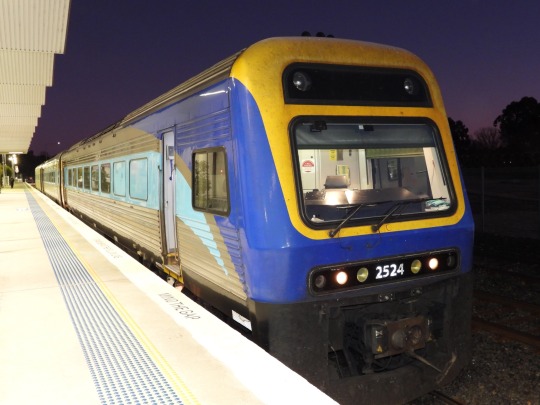
I am something of a regular at Peter Nathan Toy Soldiers, by which I mean I go there maybe twice a year. I am sure this counts as being a regular. One might perhaps find it paradoxical that I wax philosophical about the horrors of war while collecting my little pewter troopers. My response is to paraphrase the great author H. G. Wells, who, when the paradox of his being a pacifist and an avid miniature wargamer was brought up, responded that ‘tin soldiers do not leave tin widows and tin orphans.’ And I like to think I have a bit of taste as to what I collect - I don’t collect wounded soldiers (as much as I tease Mum about getting that bayoneted Jacobite - she likes Outlander, you see), and the SS are completely verboten, thank you very much. But I am also keenly aware that this hobby attracts what we might charitably call oddballs. I overheard the owner in a discussion about how the most popular topics for toy soldier collection are Romans and the Nazis. Make of that what you will.
Perhaps I’m being too judgemental. I’m sure there are people who think my collection of British redcoats is problematic. Not everyone with an interest in the Nazi military is a neo-Nazi - but these days, I find it helps to maintain a healthy scepticism.

After this, I headed down to Darling Harbour and walked around the precinct of the National Maritime Museum. There’s little WWI-related there, of course - I’m not certain a single WWI Australian ship survives - but it’s still always well worth a look. One thing that annoys me is the new ‘action stations’ building - I’m sure it’s an excellent educational aid, but it blocks what used to be a good photographic angle of HMAS Vampire’s port side. I had hoped to see the replica of Janzoon’s Dufkyen, but it seems it was at sea when I was there. The submarine Onslow and the patrol boat Advance seemed in good order, and the Endeavour replica was a delight to look over as always. Of particular note was the Krait, a captured Japanese fishing boat used by Australian and British commandos in a sabotage operation in Singapore harbour - it tends to be obscured by something when I go to the museum, so it was nice to see it unobstructed today.
After that, I walked back to the Queen Victoria Building via JB-HI-FI, where I picked up a bluetooth mouse that doesn’t work. I suppose that’s twenty dollars I’ll never see again. We caught the train back to Hurstville, picked up some groceries and some KFC, and returned to the hotel, where I write this now. Tomorrow, we’ll be heading in to Hyde Park Barracks and the Anzac Memorial, and taking a trip on the ferry to Manly. I’m sure I’ll have a little more to say about all that.

8 notes
·
View notes
Text
One of the upsides of the eerie Halloween season is that you can let yourself dwell on the macabre. Even if the rest of the year you envision yourself as a hard-nosed cynic, on Halloween you are allowed to drop your scepticism and ponder the impossible ‘What if…?’
For maritime folk, there is no end of unnerving tales to scare yourself with. Oceans are vast and humans have sailed the seven seas long enough that you can take your pick of myths or unsolved mysteries that will keep you awake with chills, well into the night. Leaving aside sea monsters, murderous pirates or alien encounters, it is the appearance of ghost ships that can really raise the hair on your neck. The thought of these silent and abandoned vessels aimlessly making their way across oceans is disconcerting, to say the least.
…
In 1750, the Sea Bird was close to Newport Harbour, Rhode Island, when onlookers noticed there was no crew on the deck. The ship then sailed itself through the rough breakers to beach itself gently on Easton’s Beach.
Tentative witnesses boarded the silent vessel but were aghast to find the ship deserted. The cargo was still in the hold and, as in all good ghost stories, the kettle was boiling on the stove. An ‘elaborate breakfast’ was said to be waiting on the table. Even a dressing gown was noted as being carelessly tossed aside.
Naturally, there were no signs of violence. No signs of robbery or even sickness. Possessions and instruments were left in their places. One of the longboats was absent, suggesting the crew might have taken flight in a fit of panic – but nothing suggested why…. It was even ‘recorded’, though no one can confirm where (ah, folktales), that the captain himself was spotted only hours earlier on the deck of the Sea Bird by passing fishermen.
Yes, the spookiness is always in the details.
2 notes
·
View notes
Text
The two roles of records and archives – accountability and heritage, a seminar at Vokasi Universitas Indonesia, 6 Sep 2023
I was a guest of the records management program at Vokasi UI, hosted by Mrs Wiwiet Mardiati.
Title: The two roles of records and archives – accountability and heritage
Abstract:
Archives and records play two roles in society. One role is to support business, government and organisations to be efficient and show how decisions are made and what work is done. The other role is to support societies’ memory by keeping some information long term as archives.
There have been different approaches over time by archivists and records managers to sharing these tasks. Sometimes lines have been drawn and archivists have looked after old records and records managers have looked after current ones. Since computers were introduced in Australia, archival thinking has been applied to managing current records. This has been to make sure archivists can be advocates for looking after the records that must be kept long term as archives. The thinking here was that in the fragile environment of computers, early intervention by archivists working with or as records managers was crucial. Otherwise, archives could easily be lost.
Records get kept in Australia for both business reasons and for memory reasons. What drives organisations to keep them? Legislation is one factor – our archival authorities have laws that require government records to be kept, including archives. There are also laws that affect business records in different industries and sectors. But this focus on compliance delivers mixed results. The records community in Australia is putting more emphasis on supporting bigger organisational goals, finding compliance has limited effect. Louise will share observations about why records are kept drawing on professional practice she has observed during her teaching, focusing on the drivers beyond compliance and business efficiency. It is a challenge to teach these twin roles of records in accountability and cultural heritage to students. Louise will share some of the approaches she takes and the content she covers. Finally, Louise will foreshadow some opportunities for dialogue between teachers of archives and records in Australia and Indonesia.
Bio:
Dr Louise Curham is a lecturer in the Libraries, Archives, Records and Information Science discipline in the Curtin University iSchool. Louise leads teaching in the archives and records area. Louise joined the tertiary sector in 2020 after two decades working in government information, community records and audiovisual collections. She has held policy and project-based roles at the National Archives of Australia (2002-2007; 2009-2019) and the Australian National Maritime Museum (2008-9). Louise's research focuses on objects that elude meaningful digitisation. Louise is an accredited professional member of the Australian Society of Archivists and a past council member. She is actively involved in Australia’s records management community and the international digital preservation and audiovisual archives communities.
2 notes
·
View notes
Text
Lecturing aboard Cruise Ships
youtube
One of the greatest thrills of my career is presenting maritime lectures and talks in front of an audience. A lot of work goes into them; from researching the topics to putting slides together, but it’s worth every second for the chance to share the ocean liner story.
One of the trickiest parts is working out what stories in the long and illustrious history of the ocean liner to include. Sometimes serious culling is required to achieve the end result of a fast paced, informative and engaging talk.
My lectures generally run for about 45 minutes and cover a range of topics spanning from the 1830s to today. I’m always happy to chat after the lecture so if you’re attending one of my talks come and say hi and share your story.
What do I talk about?
It’s probably no surprise that my maritime lecture topics cover ocean liners and cruise ships past and present.
However, what’s really interesting about this subject is how ocean liners have been involved in almost every world event. As such, the talks offer glimpses into Victorian life, the evolution of technologies such as steam engines, electric lighting and turbines, as well as the militarisation of ships during both World Wars.
Some of my topics include:
The evolution of passenger ship design,
The changing use of passenger ships, from mail services, immigration, tourism and modern cruising,
How the ocean liner evolved into the cruise ship in the jet age,
Ocean Liners during World War I and World War II,
Disasters such as Titanic and Lusitania, and the lessons learnt from these tragedies,
Cunard Line, White Star Line and P&O History, as well as talks that cover many other shipping lines such as Collins Line, Inman Line, Orient Line, Norddeutscher Lloyd, Hamburg-Amerika, CGT French Line, Italia Line, United States Lines… to name a few!
Where do I talk?
My first ever maritime lecture was in August 2008 aboard the QE2 during a Mediterranean cruise that was part of her farewell season. Speaking aboard QE2 had been a long-term goal of mine so I jumped at the opportunity and haven’t looked back.
Since then I’ve spoken at venues all over the world including many engagements on various cruise ships. Some highlights include engagements aboard Queen Mary 2, Queen Elizabeth and Queen Victoria for Cunard, P&O UK's Aurora and P&O Australia’s Pacific Eden, Pacific Jewel and Pacific Explorer.
I regularly speak at maritime museums, with recent engagements at the Australian National Maritime Museum, New Zealand Maritime Museum and Sea City Museum in Southampton England.
I have also been a keynote speaker at conferences and events including two engagements at the Cancer Council’s annual fundraising luncheon at the Hilton Hotel.
2 notes
·
View notes
Text
Must Visit Places in Adelaide, SA
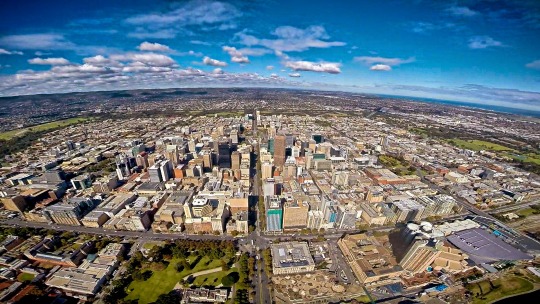
I. Introduction
Adelaide is a charming city located in the southern region of Australia. Known for its picturesque beaches, beautiful parks, and rich culture, Adelaide is a popular tourist destination for both locals and visitors alike. In this article, we will highlight some of the must-visit places in Adelaide that will make your visit unforgettable.
II. Historical Places
A. Adelaide Oval
Since 1871, Adelaide Oval has been a recognisable landmark on the city's skyline. The stadium has played host to numerous international sporting events and served as the home of cricket and Australian rules football in South Australia. Adelaide Oval not only hosts sporting events but also offers guided tours that give guests an inside look at the stadium's background and amenities.
B. Port Adelaide Historic District
Port Adelaide is a historic district located approximately 14 km north-west of Adelaide’s city center. The district has been beautifully preserved and offers visitors a glimpse into Adelaide’s maritime history. Visitors can explore the district’s many museums, galleries, and historic buildings, including the National Railway Museum and the South Australian Maritime Museum.
C. Adelaide Gaol
Adelaide Gaol is a former prison that was in operation from 1841 to 1988. The gaol has been beautifully restored and is now a museum that offers visitors a look at what life was like for prisoners in the 19th and early 20th centuries. Visitors can take a guided tour of the gaol and explore the cells, exercise yards, and execution chamber.
III. Nature and Parks
A. Adelaide Botanic Garden
The Adelaide Botanic Garden is a beautiful park located in the heart of the city. The garden features a range of themed gardens, including a medicinal plant garden, a rose garden, and a palm house. The garden also hosts a range of events and exhibitions throughout the year, making it a great destination for visitors of all ages.
B. Cleland Conservation Park
Cleland Conservation Park is a beautiful natural reserve located approximately 20 km south-east of Adelaide’s city center. The park is home to a range of wildlife, including kangaroos, koalas, and emus. Visitors can explore the park’s walking trails, which offer stunning views of the surrounding landscape.
C. Morialta Conservation Park
Morialta Conservation Park is a beautiful natural reserve located approximately 10 km north-east of Adelaide’s city center. The park is home to a range of walking trails, including the popular Three Falls Trail, which takes visitors past three stunning waterfalls. The park is also a popular destination for rock climbing and abseiling.
IV. Food and Drink
A. Central Market
The Central Market is a historic market located in the heart of Adelaide’s city center. The market features over 80 stalls, selling everything from fresh produce to gourmet cheeses and artisanal bread. The market also has a range of cafes and restaurants, making it a great destination for foodies.
B. Adelaide Hills Wineries
There are some of Australia's top wineries in the Adelaide Hills. Visitors can take a wine tour of the area and stop by several cellar doors, such as Shaw and Smith Winery and Hahndorf Hill Winery. The area is also home to a variety of eateries and cafes, giving visitors the chance to eat and drink while admiring the breathtaking views.
C. Peel Street
Peel Street is a popular dining precinct located in Adelaide’s city center. The precinct is home to a range of restaurants and bars, offering everything from modern Australian cuisine to Asian fusion dishes. Peel Street is a great destination for foodies looking to explore Adelaide’s vibrant dining scene.
V. Art and Culture
A. Art Gallery of South Australia
The Art Gallery of South Australia is a must-visit destination for art lovers. The gallery features a range of artworks, including paintings, sculptures, and photographs, from Australian and international artists. The gallery also hosts a range of exhibitions and events throughout the year, making it a great destination for visitors of all ages.
B. South Australian Museum
The South Australian Museum is a must-visit destination for anyone interested in natural history and cultural heritage. The museum’s collection features over 4 million objects, including fossils, minerals, and artifacts from Aboriginal and Pacific Islander cultures. The museum also hosts a range of exhibitions and events throughout the year, making it a great destination for visitors of all ages.
C. Adelaide Festival Centre
In the centre of the city is a centre for culture called the Adelaide Festival Centre. The centre has a variety of performance venues, such as theatres and concert halls, and it hosts a variety of events and performances all year long in the performing arts, such as music, dance, and theatre. The centre is a great place to spend a night out because it also has a variety of bars and restaurants.
VI. Family-Friendly Places
A. Adelaide Zoo
The Adelaide Zoo is a must-visit destination for families. The zoo is home to over 2,500 animals from over 250 species, including pandas, lions, and giraffes. The zoo also offers a range of experiences, including animal encounters and behind-the-scenes tours, making it a great destination for visitors of all ages.
B. Glenelg Beach
The beach at Glenelg is a favourite spot for tourists and families. The beach is a great place to spend the day because it has a variety of amenities like cafes, restaurants, and playgrounds. The historic Glenelg Tram, which runs from the city's centre to the beach, is another option for tourists.
C. Adelaide Himeji Garden
The Adelaide Himeji Garden is a Japanese-style garden located in the southern part of Adelaide’s city center. The garden features a range of traditional Japanese elements, including a koi pond, a teahouse, and a bamboo forest. The garden is a great destination for families looking to escape the hustle and bustle of the city.
VII. Conclusion
Adelaide is a stunning city with something to offer everyone, including historical structures, stunning natural attractions, delicious food and drink, and a thriving arts and culture scene. Adelaide is unquestionably worthwhile a visit, regardless of whether you're travelling alone, with friends, family, or as a couple. We hope this article has given you the desire to explore the city and find all of its wonderful hidden gems.
Reaching for AC Repair, Adelaide, SA? White Air Services has been keeping South Australian’s comfortable at home and work for over 25 years. Their Air Conditioning Technicians are fully trained and experienced with all air conditioning brands, split systems, evaporative, and reverse cycle systems. Whether your Air Conditioner is due for a service to keep it running efficiently or you need an urgent repair, White Air Services can help you.
Business Details:
White Air Services 0439446722 76 Torres Ave, Flinders Park SA 5025, Australia https://whiteairservices.com.au/
Social Media:
Facebook
1 note
·
View note
Text
Discover Darling Harbour | Sydney's Vibrant Waterfront Playground

Darling Harbour is one of Sydney's most popular and dynamic destinations, offering a vibrant mix of shopping, dining, entertainment, and cultural experiences. Located just west of the city center, Darling Harbour is a waterfront area that has undergone significant redevelopment in recent decades, transforming it from a working port into a bustling hub for tourists and locals alike. Whether you're looking for family-friendly activities, world-class attractions, or a place to relax by the water, Darling Harbour has something for everyone.
Historical Significance of Darling Harbour
Historically, Darling Harbour was an essential part of Sydney's maritime industry. In the 19th century, it was a busy working port, playing a crucial role in the transportation of goods to and from Sydney. The area was named after Lord Darling, the Governor of New South Wales from 1825 to 1831, who played a role in the development of the area.
During the 20th century, however, Darling Harbour began to decline as a commercial port. By the 1980s, the waterfront area was largely abandoned, and there was growing interest in revitalizing the site. In the 1980s and 1990s, a major redevelopment project transformed Darling Harbour into the modern, vibrant precinct it is today. The area was officially redeveloped for public use in time for Australia’s Bicentennial celebrations in 1988, marking a turning point in the site's history. This ambitious transformation turned Darling Harbour into a hub for cultural institutions, entertainment, and tourism.
Today, Darling Harbour is one of Sydney's busiest and most beloved locations, representing a blend of historical significance and contemporary urban development.
What to Do at Darling Harbour
Darling Harbour offers a wealth of attractions and activities for all ages, making it one of the city's most visited areas. Here's a look at the top things to do:
SEA LIFE Sydney Aquarium: One of Darling Harbour's flagship attractions, the SEA LIFE Sydney Aquarium is home to a vast array of marine life. Visitors can explore interactive exhibits and get close to sea creatures such as sharks, rays, and the iconic dugong. The aquarium also features specialized zones, including the Great Barrier Reef and Penguin Expedition, offering an educational and fascinating experience for all ages.
WILD LIFE Sydney Zoo: Situated next to the aquarium, WILD LIFE Sydney Zoo offers a chance to see Australia’s native animals up close. From kangaroos and koalas to crocodiles and wombats, the zoo provides an immersive experience into Australia’s unique wildlife. It’s a great destination for families, with hands-on experiences and educational opportunities for children.
Australian National Maritime Museum: For those interested in maritime history, the Australian National Maritime Museum is a must-visit. The museum highlights Australia’s rich naval history, including exhibitions on famous ships like the HMAS Vampire, an Australian naval destroyer, and the Endeavour Replica, a replica of Captain James Cook’s famous ship. The museum also features rotating exhibitions on themes like exploration, trade, and the ocean.
Darling Harbour Ferry Ride: One of the best ways to experience Darling Harbour is from the water. Visitors can take a ferry ride around the harbour to enjoy stunning views of the city skyline, the Sydney Opera House, and the Harbour Bridge. The ferry ride offers a unique perspective of the area and is a relaxing way to explore the waterfront.
Chinese Garden of Friendship: A peaceful oasis amidst the bustling harbour, the Chinese Garden of Friendship is a beautifully landscaped garden inspired by traditional Chinese design. It features tranquil ponds, waterfalls, and bridges, offering a serene escape from the city's hustle and bustle. The garden is also home to exotic plants, koi fish, and birds, making it a perfect spot for relaxation and reflection.
Cockle Bay Wharf: This bustling area within Darling Harbour is filled with restaurants, cafes, and bars offering a range of cuisines, from casual dining to fine dining experiences. Visitors can enjoy outdoor dining with views of the water and the vibrant surrounding area. It’s also a great spot for evening drinks, as the lights of the harbour and city create a beautiful backdrop.
Barangaroo Reserve: Just a short walk from Darling Harbour, Barangaroo Reserve is a stunning urban park that offers sweeping views of the Sydney Harbour. The park is named after Barangaroo, a Cammeraygal woman and influential Aboriginal figure. It features walking paths, native plants, and open spaces perfect for picnics and outdoor activities.
Shopping and Entertainment: Darling Harbour is home to some of Sydney’s best shopping and entertainment venues. Harbourside Shopping Centre offers a range of stores and a food court, while The Star Sydney, a nearby casino and resort complex, features luxury shops, high-end restaurants, and an expansive gaming area. Additionally, the International Convention Centre (ICC Sydney) hosts major events, concerts, and exhibitions throughout the year.
When to Visit Darling Harbour
The best time to visit Darling Harbour largely depends on the type of experience you’re looking for.
Summer (December to February): Sydney’s summer is the peak tourist season, and Darling Harbour is especially lively during this time. Expect warmer weather, outdoor events, and bustling crowds. If you’re planning to visit during summer, consider arriving early in the day or booking tickets for attractions in advance.
Autumn (March to May): Autumn is one of the most pleasant times to visit, with mild temperatures and fewer crowds. The weather is perfect for outdoor activities, and you can enjoy the beautiful gardens, walkways, and parks that Darling Harbour has to offer.
Winter (June to August): While Sydney’s winters are relatively mild, the colder temperatures mean fewer tourists. If you prefer a quieter visit, winter is a great time to explore indoor attractions like the SEA LIFE Sydney Aquarium or the Australian National Maritime Museum without the crowds.
Spring (September to November): Spring brings pleasant weather and an increase in outdoor activities and festivals. It’s a fantastic time to enjoy the outdoor spaces and gardens in Darling Harbour, and many of the attractions begin to host special events.
How to Plan Your Journey to Darling Harbour
Getting to Darling Harbour is easy and convenient, with several transportation options available.
By Train: Darling Harbour is well-served by public transport, with Town Hall Station and Wynyard Station both within walking distance. The Light Rail also connects Darling Harbour to surrounding areas like Pyrmont, the Inner West, and the Eastern Suburbs.
By Ferry: If you’re coming from Circular Quay or other parts of Sydney Harbour, the Ferry is a scenic option. Darling Harbour is easily accessible from the ferry terminal at Barangaroo Wharf, a short walk from the central attractions.
By Bus: Numerous bus routes pass through Darling Harbour, connecting the area to many parts of Sydney.
By Car: While driving to Darling Harbour is an option, parking can be limited, and it may be easier to use public transport, particularly if you’re visiting during peak tourist seasons.
Why Darling Harbour is So Famous
Darling Harbour is famous for being a lively, multifaceted destination that offers a unique combination of history, culture, entertainment, and dining. It is an iconic part of Sydney’s waterfront, with something for everyone—whether you’re visiting with family, friends, or as a solo traveler.
Its rich history, as a former industrial port turned recreational space, gives the area a distinct charm and sense of transformation. Today, it is recognized for being a central location in Sydney for tourism, leisure, and events. From the remarkable cultural institutions like the Australian National Maritime Museum to modern attractions like the ICC Sydney, Darling Harbour has evolved into a must-visit location for anyone coming to Sydney.
Whether you’re after world-class attractions, a scenic spot for relaxation, or a place to shop, eat, and enjoy the water, Darling Harbour is a destination that perfectly captures the dynamic energy and beauty of Sydney.
#famous place#places to visit#places to go#places to travel#places to see#places to read#Australia#NSW#sydney harbour#darling harbour
0 notes
Text
Kid-Friendly Activities in Major Cities For cheap and best Travel Diaries - https://travelinternationals.com/
Exploring major cities with kids can be an enriching and fun-filled adventure when you know where to look for family-friendly activities. From interactive museums to sprawling parks, each city offers unique attractions that cater to children of all ages. Here’s a guide to some of the best kid-friendly activities in popular urban destinations.
1. New York City, USA In New York City, families can visit the iconic Central Park, which features playgrounds, a carousel, and the Central Park Zoo. The American Museum of Natural History is another favorite, where kids can marvel at dinosaur skeletons and engage in hands-on exhibits. Don’t miss the High Line, a unique elevated park offering a safe walking area with gardens and views of the city.
2. London, UK London is a treasure trove of activities for children. The Natural History Museum, with its lifelike dinosaur exhibits, is a hit among young ones. A visit to the Tower of London brings history to life with interactive displays. Hyde Park offers open spaces for picnics and boating, while the London Transport Museum provides a fascinating look at the city’s history of travel.
3. Sydney, Australia In Sydney, the Taronga Zoo lets kids get close to kangaroos and koalas, while Darling Harbour features attractions like SEA LIFE Sydney Aquarium and the Australian National Maritime Museum. Bondi Beach’s shallow waters and surf lessons for kids are perfect for a family day by the sea.
4. Tokyo, Japan Tokyo’s diversity makes it a fantastic destination for families. Tokyo Disneyland and DisneySea are magical for children. The National Museum of Nature and Science features hands-on exhibits and life-size models of dinosaurs. Don’t forget Ueno Zoo, Japan’s oldest zoo, for a delightful experience with pandas and other animals.
5. Paris, France The City of Light has plenty for children. Jardin du Luxembourg offers puppet shows, pony rides, and playgrounds. The Cité des Enfants, part of the Science Museum, provides interactive exhibits designed specifically for young minds. For a magical experience, take a short trip to Disneyland Paris.
By planning activities that cater to children’s interests, you can make city exploration enjoyable for the whole family.
#KidFriendlyCities, #FamilyTravel, #TravelWithKids, #KidFriendlyActivities, #MajorCityAttractions, #TravelDiaries, #BestTravelDestinations, #FamilyAdventures
0 notes
Text
Le parc national de Kakadu est situé dans le nord de l'Australie, où vous pourrez découvrir la richesse de la vie animale et végétale de ce beau pays

En outre, il existe des peintures rupestres d'aborigènes, dont l'âge est supérieur à 25 000 ans.
En Australie, les attractions artificielles sont indiscernables des attractions naturelles.
Les points forts de l'Australie incluent la flore et la faune inhabituelles du continent, Ayers Rock, une montagne de terre rouge, des oasis au milieu du désert et la Grande Barrière de Corail, qui est inscrite sur la Liste du patrimoine mondial des Nations Unies.
Sydney est une belle ville dans le monde. Il combine le monde industriel moderne avec ses gratte-ciel et les anciens bâtiments de King's Cross and the Rocks, ses parcs et ses boulevards et ses quartiers asiatiques. À Sydney, il vaut la peine de visiter le célèbre Sydney Museum of Australian History and Anthropology, le Museum of Modern Art, le Nicholson Museum of Antiquities, le National Maritime Museum, l'Australian Wildlife Park et Hyde Park. La promenade dans le quartier de Woolumulu et la fabrique d'opale, où l'on peut acheter des bijoux en opales, perles ou diamants, méritent une attention particulière. Sydney vaut le détour, ne serait-ce que pour s'imprégner de l'esprit de l'Australie, pour ressentir sa nature contrastée et contradictoire, séduisante par son unicité.
#voyage#lesvues#pays#apprendlemonde#temps#bonjourvoyage#repos#joie#plaisir#environnementinconnu#faitsintéressants#finaguide
0 notes
Text
6 Disability-Friendly Activities to Enjoy in Sydney

Sydney is a vibrant city known for its iconic landmarks, beautiful beaches, and a wide range of activities that cater to everyone, including people with disabilities. Whether you’re a local or visiting the city, there are plenty of accessible and disability-friendly experiences to enjoy. With the support of various disability support services in Sydney, the city is increasingly inclusive, ensuring that individuals of all abilities can explore its attractions comfortably. Here are six disability-friendly activities to enjoy in Sydney.
1. Explore the Sydney Opera House with Accessible Tours
The Sydney Opera House, one of the world’s most famous architectural masterpieces, offers a range of accessible tours designed for visitors with disabilities. These tours provide access to performance spaces, backstage areas, and stunning views of Sydney Harbour. The Opera House has ramps, lifts, and accessible seating options to accommodate guests with mobility impairments, and the tours are tailored to ensure everyone can enjoy the cultural experience.
Accessibility Features: Ramps, elevators, hearing loop systems, and accessible toilets.
Special Services: Audio-described tours, Auslan (Australian Sign Language) interpreted tours, and sensory tours designed for visitors with autism.
Exploring the Sydney Opera House is a fantastic way to connect with Sydney’s cultural scene, and the venue’s commitment to accessibility ensures that everyone can participate in the magic of this iconic location.
2. Stroll Through the Royal Botanic Garden
Sydney’s Royal Botanic Garden offers a peaceful and picturesque environment with pathways that are wheelchair-friendly and accessible for people with different mobility needs. The garden’s wide, flat paths make it easy to explore the diverse plant collections, beautiful water features, and open green spaces.
Accessibility Features: Wheelchair-accessible paths, accessible restrooms, and benches throughout the garden.
Guided Tours: There are free guided tours available, including special tours for people with visual impairments.
The Royal Botanic Garden is a serene spot for a day out, providing a break from the bustling city while remaining close to major attractions like the Sydney Opera House and Circular Quay.
3. Enjoy the Views at Sydney Harbour Bridge and Accessible Lookouts
The Sydney Harbour Bridge is an iconic symbol of the city, and there are accessible ways to experience its breathtaking views. While the famous BridgeClimb might not be suitable for all, the Pylon Lookout offers an excellent alternative with a series of ramps and accessible viewing platforms.
Accessibility Features: Ramps, elevators, and accessible viewing platforms at various points around the harbour.
Accessible Walkways: Circular Quay to Barangaroo via the harbour foreshore offers scenic and accessible walkways suitable for wheelchairs and mobility aids.
For a different perspective, consider a harbour cruise on an accessible vessel, where you can see the bridge, Opera House, and city skyline from the water.
4. Relax at Accessible Beaches like Manly Beach and Bondi Beach
Sydney is renowned for its beautiful beaches, and many of them are becoming increasingly accessible to ensure everyone can enjoy the sun, sand, and surf. Manly Beach and Bondi Beach are two of Sydney’s most famous coastal destinations that offer disability-friendly amenities.
Accessibility Features: Accessible bathrooms, beach wheelchairs available for hire, and ramp access to the sand.
Accessible Beach Mats: Some beaches, including Bondi, have accessible beach mats that extend across the sand, allowing easy wheelchair access to the water.
These beachside experiences offer a fantastic way to enjoy Sydney’s coastal lifestyle, whether it’s a stroll along the promenade, enjoying a meal at an accessible café, or taking a dip in the ocean.
5. Visit the Australian National Maritime Museum
The Australian National Maritime Museum, located at Darling Harbour, offers a range of accessible exhibits that delve into Australia’s rich maritime history. The museum’s design is highly inclusive, with wheelchair access throughout, tactile displays, and interactive exhibits that cater to all visitors.
Accessibility Features: Accessible parking, wheelchair access, hearing loops, and audio guides.
Special Exhibits: Tactile experiences and interactive exhibits are designed for visitors with sensory impairments.
This museum provides a fun and educational experience, with exhibitions that are engaging and accessible for people of all abilities.
6. Enjoy Accessible Wildlife Experiences at Taronga Zoo
Taronga Zoo, located on the shores of Sydney Harbour, is a fantastic destination for animal lovers. The zoo is committed to accessibility, offering a variety of services to ensure all visitors can enjoy their day. Wheelchair-accessible paths wind through the exhibits, and the zoo provides accessible transport options within the grounds.
Accessibility Features: Wheelchair-accessible pathways, ramps, accessible restrooms, and accessible parking.
Additional Services: Free wheelchair hire, sensory maps for visitors with autism, and mobility assistance via accessible transport options within the zoo.
Visiting Taronga Zoo offers a unique opportunity to encounter wildlife up close, from native Australian animals to exotic species, all while enjoying panoramic views of Sydney Harbour.
Conclusion
Sydney offers a wealth of disability-friendly activities that cater to individuals of all abilities, making it a truly inclusive city. From iconic landmarks and tranquil gardens to accessible beaches and engaging museums, there’s something for everyone. Thanks to ongoing improvements and the support of disability support services in Sydney, these activities are designed to provide enjoyable and memorable experiences for all visitors. Whether you’re looking for relaxation, adventure, or education, Sydney’s accessible attractions ensure that everyone can be part of the action.
0 notes